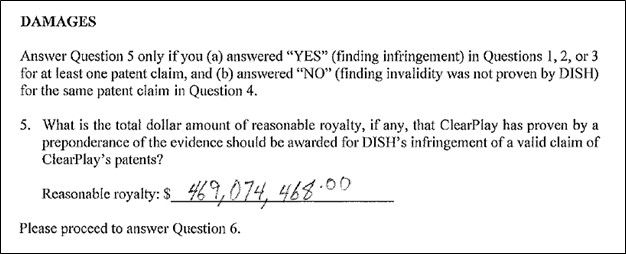The best inventions cure a historical illness. Ibuprofen for headaches, caffeine for fatigue, and of course—DISH Network's "AutoHop" feature for skipping commercials. DISH introduced this new feature with great fanfare, including a kangaroo mascot and—ironically—several commercials of its own. But a jury in Utah found last week that Dish infringed the claims of two patents owned by ClearPlay and found damages in the amount of $469 million. A portion of the jury verdict form is below:

ClearPlay relied on a "reasonable royalty" damages theory in reaching this gargantuan number. That theory is ubiquitous in patent damages jurisprudence and looks to fifteen separate factors, none of them dispositive. In sum, however, it tries to determine what the parties would have agreed was a "reasonable royalty" had they hypothetically negotiated a licensing agreement at the moment of first infringement.
DISH launched AutoHop in 2012, meaning the damages period continued from 2012 until present day. The large damages award can then be explained by a daunting eleven years of infringement to account for. That comes out to more than $42.6 million per year.
To me this seems a bit steep and not reflective of the hypothetical negotiation analysis. DISH did not acquire any technology from ClearPlay—it built the AutoHop feature itself or through collaboration with another developer. The hypothetical negotiation only provided DISH with a license to use the technology and not the technology itself. So the question becomes—would DISH really have paid $42.6 million per year for the right to create its own commercial-skipping technology? Could it not have achieved the same goal of skipping commercials with a different function that avoided ClearPlay's patent?
DISH will naturally ask these questions on appeal to the Federal Circuit, which has increasingly affirmed more district court cases in recent years. But the lengthy damages period will no doubt be a thorn in DISH's side as it tries to negotiate a settlement during the appellate process.
The content of this article is intended to provide a general guide to the subject matter. Specialist advice should be sought about your specific circumstances.


